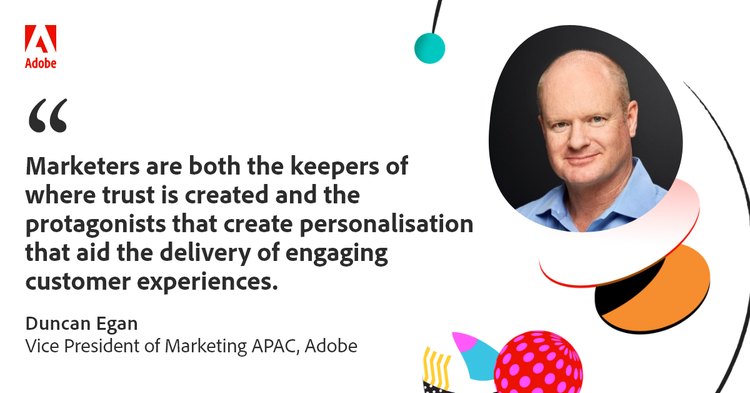A marketer’s conundrum: Balancing personalisation and privacy to deliver trust-based customer experiences

Trust is the pivot point where the balance between personalisation and privacy rests.
Without trust, privacy concerns will rightly gain sway. 90 percent of executives say privacy is a fundamental part of the customer experience. A similar proportion of customers are willing to walk away if their privacy is not respected.

Equally, trust – backed by informed consent – is the only foundation upon which real-time personalisation can be established. Customer permission to share data is a “function of trust”, the 2021 Digital Trends report concludes.
Marketers are both the keepers of where trust is created and the protagonists that create personalisation that aid the delivery of engaging customer experiences.
The risks associated with getting this balance right are huge and only likely to increase as the era of cookieless marketing looms large. For example, it’s estimated that less than 37 percent of users worldwide have opted in to allow apps to track them following Apple’s privacy-related iOS14.5 changes to its operating system — and that’s taking an optimistic view.
So how can marketers ensure they strike the right balance and don’t overcomplicate the opportunity? Following some simple privacy and personalisation strategies and tactics are key.
Collaborate closely with your C-suite peers
Marketers may find themselves in the sweet spot of personalisation and privacy and struggle to manage all aspects of the balancing act alone. Working closely with the CIO to understand data security and data flow is essential to an informed, multi-dimensional approach to customer data. Product and customer teams need to take a privacy-by-design approach to business and then with their legal teams to understand what’s coming from a privacy regulation point of view.
Consider: Conducting a privacy impact assessment of any new projects to map how information is collected, how it will flow, who can access it, how it will be stored, what it will be used for, and so on.
Avoid: Don’t wait for the regulator or moves by big tech companies to act. Jumping ahead of the market gives you the chance to be proactive, see how customers respond and fine-tune your approach.
Take a customer-centric approach
Put your customer at the heart of your customer experience management.
75 percent of senior executives say marketing has taken a more active role in strategy during the pandemic because of their ability to understand the changing behaviour of digital customers based on data. Analyse customer data and be the voice of the customer in your organisation.
Consider: Being as transparent as possible about privacy, including why you’re collecting some forms of data and what you intend to do with it.
“If you’re going to do anything, make sure you’re transparent, and make sure you ask for permission,” said Stephen Eyears, Head of Strategy, Innovation and Business Development at 7-Eleven.
Avoid: Being “tricky”.
“Another test we use internally is asking: Are we being tricky here?” says Eyears. “That’s a red flag for us — and if we think we are, then we back off.”
3. Give consumers control
Autonomy is an important principle. While it’s common to offer web users the ability to stipulate the type of cookies collected when they’re on your site, best practice includes enabling consumers to monitor and change their consents. According to Deloitte, this kind of consent management can make privacy a brand differentiator
Make sure you present your privacy policy in simple language, focusing on what’s important to the reader while avoiding legal jargon. Detail the personal information you’re collecting and why, what you do with it, where it’s held, and so on. That way, your customers are fully informed.
Consider: Creating a complete online privacy portal. At Adobe, we’ve established a privacy centre that offers customers the ability to manage their consents at any time.
Avoid: Using data in a way your customers do not expect.
“If consumers feel like they are in control of their data, and it’s not creepy, personalised messages are far more effective,” says Marketing Consultant Jon Bradshaw. Equally, when an experience is based on data, they haven’t deliberately shared, which we can all agree is an advantage is lost.
4. Develop your first-party data strategy
With third-party cookies on the way out, access to quality privacy-compliant, first-party data will allow brands to build trusted relationships with their customers while still delivering exceptional customer experiences.
Get your first-party data in order. Consider the purpose for which you want to use it, then decide if you need to augment that data with additional information.
Consider: A new “value exchange” to persuade your customers to provide additional personal information, which may include greater convenience, a superior digital experience, access to premium content, or free or discounted products and services.
Avoid: Assuming your internal data handling processes will be followed. Use technology to proactively protect consumer privacy, such as ensuring privacy compliance is built into tools.
5. Develop a personalisation strategy
Delivering a personalised customer experience requires a whole-of-company approach sponsored from the top-down, based on operational, privacy-compliant, customer data with real structure against it, such as KPIs.
Consider: It’s essential to have a budget to fund a personalisation strategy as it requires operational data, education, training and technology to deliver it.
Avoid: Thinking it can be one person’s job. Appointing a head of personalised marketing and assuming the job is done is one of the biggest mistakes we see.
6. Bring all your data together
Data integration across systems is the key to developing a single customer profile, which is the basis of personalised marketing. Nine out of ten marketers understand this is essential, but only 48 percent offer personalised content.
At the 2021 Adobe Summit, MG Motor India Head of Marketing, Udit Malhotra, described to audiences how the company stitches together cross-channel data to personalise experiences. When a potential customer comes into a dealership, the dealer knows the top five pages on their website they visited online, their lead score and whether they have pre-configured a car online, using their mobile number or email as a unique identifier.
Consider: Augmenting and enriching your data with privacy-compliant external sources.
Avoid: Leaving silos of customer data that cannot be used in real-time to personalise the customer experience.
7. Operationalise your first-party data
Once you have a centralised customer profile, implement personalisation technology that can ingest your available data and activate it by orchestrating – in real-time — the next best content, offer or experience to achieve your business goals.
Singapore-based telco M1, implemented a new website and content management system, combined that website data together with information from 20 other sources, and built a foundation from which it can offer hyper-personalised recommendations.
“There are more than six million unique combinations of services people can take,” says Chief Digital Officer Nathan Bell. “All of those things combined means every man, woman and child in Singapore would be able to have their own unique plan if they so desired.”
Consider: Contextualising your data to ensure your offers are relevant without being over the top.
Avoid: Overlooking essential customer data. For example, not considering whether your customer has a complaint in progress will punch holes in your customer experience.
8. Democratise data use and access in your organisation
The more you can put up-to-date, relevant data in the hands of staff across your organisation, the better. A specialist data team linked to marketing can help disseminate best practice, but direct access to dashboards and configurable search queries will mean a more dynamic customer experience.
Educate your staff in the empathetic use of data, data protection principles and privacy compliance to avoid data breaches that result from internal actions.
Consider: Empowering your team to make decisions or conduct experiments based on data. Digital content teams at WooliesX review analytics daily and make decisions about creating content to get offers to customers as quickly as possible.
Avoid: Putting all your effort into personalisation without a corresponding investment in privacy.
Considerations of privacy and personalisation must be in equilibrium to create consumer trust.
As the cookieless era fast approaches, a holistic first-party data and personalisation strategy is essential to being able to offer a unique customer experience. Just as essential is the investment in privacy that creates the customer trust that will help you build the data foundation for that experience.